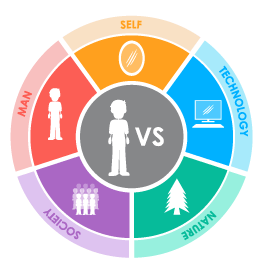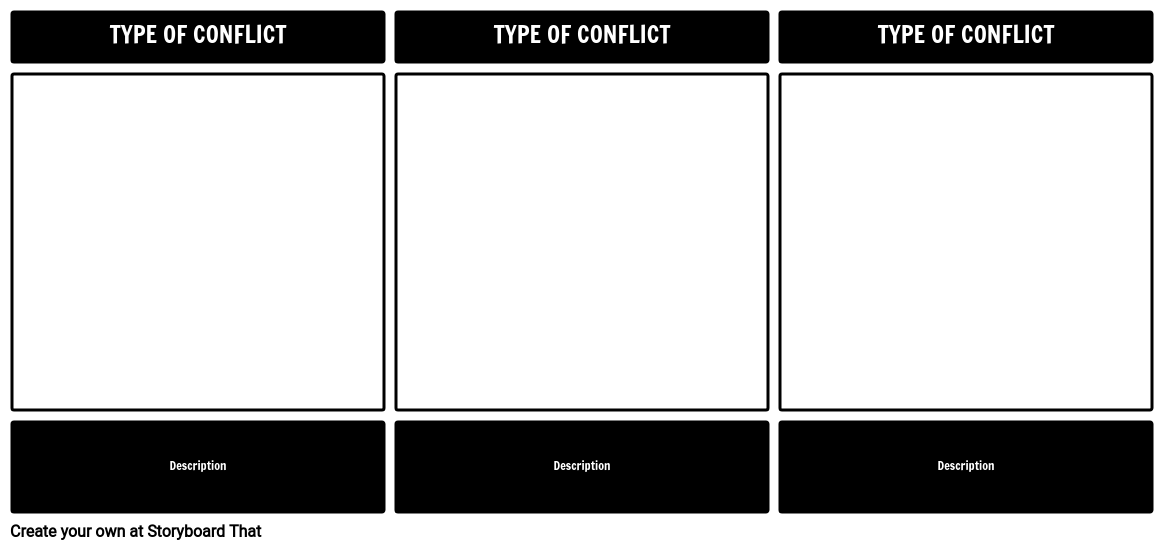Lesson Plan Overview
Storyboarding is an excellent way to focus on types of literary conflict. Have your students choose an example of each literary conflict and depict them using the Storyboard Creator. In the storyboard, an example of each conflict should be visually represented, along with an explanation of the scene, and how it fits the particular category of conflict.
Examples of Literary Conflict in Inherit the Wind
MAN vs. MAN
Drummond and Brady are facing off against each other in the courtroom throughout the case. Brady basks in the glow of the love the town throws at him because they see him as a champion for their traditional beliefs. Drummond puts Brady on the stand and makes him look ridiculous.
MAN vs. SELF
Bert wonders if going through with this case is such a good idea. The entire town is treating him like he killed someone. Rachel is desperately trying to get Bert to back down, and he considers it until Drummond asks him if he honestly believes he committed a criminal act in sharing the idea of the theory of evolution with his students. He still remains hesitant, but decides to go through with the case anyway.
MAN vs. SOCIETY
Bert is going against the law, the Butler Act, which forbade the teaching of the theory of evolution. He is standing up against his entire town, who views him as spreading evil ideas to their children. He is forfeiting his job, his home, and his reputation in the small town of Hillsboro in order to stand up against a law he feels is unjust, and to fight for the right to spread ideas.
Template and Class Instructions
(These instructions are completely customizable. After clicking "Copy Activity", update the instructions on the Edit Tab of the assignment.)
Student Instructions
Create a storyboard that shows at least three forms of literary conflict in Inherit the Wind.
- Identify conflicts in Inherit the Wind.
- Categorize each conflict as Character vs. Character, Character vs. Self, Character vs. Society, Character vs. Nature, or Character vs. Technology.
- Illustrate conflicts in the cells, using characters from the story.
- Write a short description of the conflict below the cell.
Lesson Plan Reference
Student Rubric
(You can also create your own on Quick Rubric.)
| Proficient | Emerging | Beginning | Try Again | |
|---|---|---|---|---|
| Conflict Identification | Student identifies correct major conflicts and uses strong, clear textual evidence to support choice. | Student identifies correct major conflict and uses few or unclear details to support their choice. | Student identifies incorrect major conflict, and uses some details from the text to support their choice. | Student does not attempt to identify major conflict or identifies incorrect major conflict with no explanation. |
| Understanding Outcome | Student clearly shows the outcome of the conflict and its effects on the protagonist with evidence from the text. | Student shows the outcome of the conflict and its effect on the protagonist, but some evidence is unclear. | Student shows the outcome of the conflict, but does not examine its effect on the protagonist and uses some vague textual evidence. | Student does not clearly show the outcome of the conflict or use textual evidence. |
| Character | Storyboard includes all required characters and clearly names them. Goes above and beyond by adding additional details. | Storyboard includes all required characters and clearly names them. | Storyboard includes protagonist and antagonist but leaves out other required characters. | Storyboard does not include the names of required characters. |
| Storyboard | Student clearly shows effort to convey the setting the scene of the book | Student attempts to convey setting and scene of the book, but lacks some clarity. | Student does not clearly convey the setting and scene. | Student makes little or no attempt to convey the setting or scene. |
| Spelling and Grammar | Student uses exemplary spelling and grammar. There are no errors. | Student makes a minor error in spelling and grammar. | Student makes several minor errors in spelling and grammar. | Student makes many errors in spelling and grammar; little attempt at spellchecking. |
Lesson Plan Overview
Storyboarding is an excellent way to focus on types of literary conflict. Have your students choose an example of each literary conflict and depict them using the Storyboard Creator. In the storyboard, an example of each conflict should be visually represented, along with an explanation of the scene, and how it fits the particular category of conflict.
Examples of Literary Conflict in Inherit the Wind
MAN vs. MAN
Drummond and Brady are facing off against each other in the courtroom throughout the case. Brady basks in the glow of the love the town throws at him because they see him as a champion for their traditional beliefs. Drummond puts Brady on the stand and makes him look ridiculous.
MAN vs. SELF
Bert wonders if going through with this case is such a good idea. The entire town is treating him like he killed someone. Rachel is desperately trying to get Bert to back down, and he considers it until Drummond asks him if he honestly believes he committed a criminal act in sharing the idea of the theory of evolution with his students. He still remains hesitant, but decides to go through with the case anyway.
MAN vs. SOCIETY
Bert is going against the law, the Butler Act, which forbade the teaching of the theory of evolution. He is standing up against his entire town, who views him as spreading evil ideas to their children. He is forfeiting his job, his home, and his reputation in the small town of Hillsboro in order to stand up against a law he feels is unjust, and to fight for the right to spread ideas.
Template and Class Instructions
(These instructions are completely customizable. After clicking "Copy Activity", update the instructions on the Edit Tab of the assignment.)
Student Instructions
Create a storyboard that shows at least three forms of literary conflict in Inherit the Wind.
- Identify conflicts in Inherit the Wind.
- Categorize each conflict as Character vs. Character, Character vs. Self, Character vs. Society, Character vs. Nature, or Character vs. Technology.
- Illustrate conflicts in the cells, using characters from the story.
- Write a short description of the conflict below the cell.
Lesson Plan Reference
Student Rubric
(You can also create your own on Quick Rubric.)
| Proficient | Emerging | Beginning | Try Again | |
|---|---|---|---|---|
| Conflict Identification | Student identifies correct major conflicts and uses strong, clear textual evidence to support choice. | Student identifies correct major conflict and uses few or unclear details to support their choice. | Student identifies incorrect major conflict, and uses some details from the text to support their choice. | Student does not attempt to identify major conflict or identifies incorrect major conflict with no explanation. |
| Understanding Outcome | Student clearly shows the outcome of the conflict and its effects on the protagonist with evidence from the text. | Student shows the outcome of the conflict and its effect on the protagonist, but some evidence is unclear. | Student shows the outcome of the conflict, but does not examine its effect on the protagonist and uses some vague textual evidence. | Student does not clearly show the outcome of the conflict or use textual evidence. |
| Character | Storyboard includes all required characters and clearly names them. Goes above and beyond by adding additional details. | Storyboard includes all required characters and clearly names them. | Storyboard includes protagonist and antagonist but leaves out other required characters. | Storyboard does not include the names of required characters. |
| Storyboard | Student clearly shows effort to convey the setting the scene of the book | Student attempts to convey setting and scene of the book, but lacks some clarity. | Student does not clearly convey the setting and scene. | Student makes little or no attempt to convey the setting or scene. |
| Spelling and Grammar | Student uses exemplary spelling and grammar. There are no errors. | Student makes a minor error in spelling and grammar. | Student makes several minor errors in spelling and grammar. | Student makes many errors in spelling and grammar; little attempt at spellchecking. |
How Tos about Literary Conflict in Inherit the Wind
Organize a classroom debate on literary conflict themes
Debates help students analyze and defend their understanding of conflict types. Assign roles based on characters from Inherit the Wind and have students argue which conflict most impacts the story, fostering critical thinking and engagement.
Select debate topics that align with story conflicts
Choose debate prompts that reflect key conflicts in the play, such as 'Is Bert Cates a hero or a troublemaker?' or 'Should personal beliefs challenge societal laws?' These topics encourage students to connect literary analysis to real-world issues.
Assign roles and prepare arguments
Divide students into small groups or pairs and assign each a character or viewpoint from the play. Have them gather evidence from the text to support their position. This process strengthens textual analysis and teamwork skills.
Facilitate the debate and encourage respectful discussion
Guide the debate by establishing clear rules for speaking and listening. Encourage students to reference specific scenes and respond thoughtfully to opposing arguments, building a collaborative and respectful classroom environment.
Reflect on the debate and connect to literary conflict
After the debate, lead a class reflection on what was learned about literary conflict and character motivation. Prompt students to consider how their perspectives changed and how debates can deepen literary understanding.
Frequently Asked Questions about Literary Conflict in Inherit the Wind
What are the main types of literary conflict in Inherit the Wind?
Inherit the Wind features several types of literary conflict, including Man vs. Man (Drummond vs. Brady), Man vs. Self (Bert's internal struggle), and Man vs. Society (Bert challenging the town's beliefs). Each conflict highlights different themes and character motivations in the play.
How can I teach literary conflict using storyboards for Inherit the Wind?
To teach literary conflict with storyboards, have students identify examples from the play, illustrate each conflict type (such as Character vs. Character or Character vs. Society), and write brief explanations. Storyboards help students visualize and analyze how conflicts drive the plot and character development.
What is an example of Man vs. Society in Inherit the Wind?
A key Man vs. Society example is Bert Cates defying the Butler Act to teach evolution. He faces the town's disapproval and risks his job and reputation, demonstrating his struggle against societal norms and unjust laws.
Why is conflict important in teaching Inherit the Wind to high school students?
Conflict is crucial because it reveals character motivations, themes about freedom and belief, and encourages critical thinking. Teaching conflict helps students connect the play's issues to real-world debates and ethical dilemmas.
What are some creative ways to help students identify conflicts in Inherit the Wind?
Encourage students to use storyboards, role-play courtroom scenes, or have group discussions to explore different perspectives. These activities make identifying and understanding conflict more engaging and interactive.
More Storyboard That Activities
Inherit the Wind
Testimonials

“By using the product, they were so excited and they learned so much...”–K-5 Librarian and Instructinal Technology Teacher

“I'm doing a Napoleon timeline and I'm having [students] determine whether or not Napoleon was a good guy or a bad guy or somewhere in between.”–History and Special Ed Teacher

“Students get to be creative with Storyboard That and there's so many visuals for them to pick from... It makes it really accessible for all students in the class.”–Third Grade Teacher
© 2026 - Clever Prototypes, LLC - All rights reserved.
StoryboardThat is a trademark of Clever Prototypes, LLC, and Registered in U.S. Patent and Trademark Office







